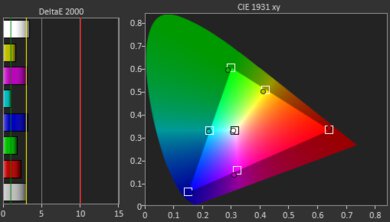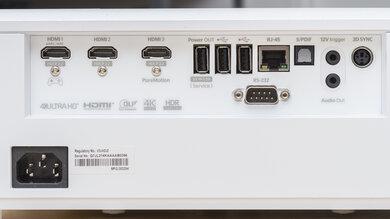The Optoma UHZ50 is a 4k DLP laser projector. It's a relatively compact standard throw projector with a 1.3x manual zoom lens and geometry features like vertical lens-shifting and keystone correction. Its laser phosphor light source allows for quieter operation than traditional lamp-based projectors, and you won't have to worry about the laser dimming over time or needing to be replaced. It supports HDR, has a built-in app store, and integrated speakers. It's also quite gaming-friendly, with an 'Enhanced Gaming' mode for an advertised input lag of 16.7ms in 4k at 60Hz or 4ms in 1080p at 240Hz.
Our Verdict
The Optoma UHZ50 is decent for watching movies. It provides a good dark-room viewing experience thanks to an impressive native contrast ratio and sufficient brightness, though it's less suited to rooms with ambient light. It also supports HDR, though it has somewhat limited coverage of the wider Rec. 2020 color gamut used in HDR content. It also doesn't display colors very accurately, and calibration doesn't improve them much.
-
Decent brightness that makes for an adequate viewing experience in dark rooms.
-
Good contrast makes content pop.
-
Mediocre color accuracy out of the box.
-
Fairly limited coverage of Rec. 2020 color space.
- 7.3 Movies
- Updated Aug 02, 2024: We've converted this review to Test Bench 0.9. We've overhauled our Contrast tests, as we now measure contrast at various average pixel levels (APL). You can see the full changelog here.
- Updated Feb 22, 2024: Review published.
- Updated Feb 20, 2024: Early access published.
Differences Between Sizes And Variants
The Optoma UHZ50 doesn't have any variants. In some markets, like Taiwan, it's called the UHC50. Though it's only been on the market for a few years, Optoma's website shows that the UHZ50 has been discontinued. There's a newer UHZ66 model with a slightly different design and a higher advertised brightness.
Compared To Other Projectors
The Optoma UHZ50 is a good projector for its price. It's bright enough to offer a decent home theater viewing experience and offers a gaming mode with low input lag. That said, it has its quirks, like limiting its gaming mode and motion interpolation functionality to specific HDMI ports. For a bit more money, you can get the Epson Home Cinema 5050UB or the BenQ HT4550i, both of which have a significantly brighter image and more accurate colors, although the Epson is less suited to gaming as it doesn't have a no low-latency mode.
See our recommendations for the best projectors for home theater and the best home projectors. If you're looking for something more general, look up our list of the best projectors instead.
The Epson Home Cinema 5050UB is better than the Optoma UHZ50, though they use different light sources. The lamp-based Epson gets significantly brighter and has a longer max throw distance. While the Optoma has a marginally better contrast ratio, the brighter image and more accurate colors of the Epson give it a better overall viewing experience, albeit in a much bigger, heavier design.
The BenQ X3000i is a better-value option than the Optoma UHZ50. Both projectors support low input lag for gaming, but the BenQ projects a brighter overall image and has significantly better color accuracy at a much lower price point.
The BenQ HT4550i is better overall than the Optoma UHZ50. Although its native contrast ratio isn't quite as good, it gets noticeably brighter, making for a more pleasant viewing experience, especially when watching in a room with ambient light. It also has more accurate colors and a wider color gamut for HDR content.
Test Results
The Optoma UHZ50 is a stationary projector and isn't very portable. It isn't the heaviest or largest projector, but it isn't exactly compact or lightweight, either. You can slightly adjust its feet, but otherwise, it's meant to be set up and left in one place.
Unfortunately, its lens doesn't have autofocus, so if you do move the projector, you'll have to manually adjust it to ensure the image is in focus. The projector has digital keystone correction but only adjusts for vertical distortion, meaning you'll have to ensure the projector is perfectly horizontal to your screen. On top of that, it has a vertical lens shift feature that allows you to adjust its vertical lens offset by up to 10%.
This is a DLP projector with a laser light source that's rated for 30,000 hours of use, meaning you'll likely never have to replace it. It projects a 4k image using pixel shift technology—while it isn't quite as sharp as native 4k, it's the next best thing and offers a much sharper image than a 1080p projector.
The Optoma UHZ50's laser is rated for 3,000 ANSI lumens, though we measured significantly less than that in our light-controlled testing setup, and it's even worse with real content, resulting in slightly dimmer colors. Still, its overall brightness is decent, especially in a dark room, though it isn't completely uniform.
The projector has good native contrast, resulting in an image that pops, with more clearly defined highlights and shadows.
The Optoma UHZ50 has mediocre out-of-the-box color accuracy. The white balance is decent, and gamma is very close to the 2.2 target curve. Its color temperature is also near-perfect. However, colors are very inaccurate, with most colors missing the mark.
The projector's color gamut is good overall. It has nearly full coverage of the Rec. 709 color space used in SDR content, but it struggles with the wider Rec. 2020 color space, resulting in duller HDR and 4k Blu-Ray content.
The Optoma UHZ50 doesn't have a built-in smart OS or pre-installed apps, but you can download apps from Optima's proprietary app store, Marketplace. That said, Optima OS runs on a customized version of Android that doesn't support Google Play Services, and the quality of its apps can vary, so you're probably better off getting a dedicated streaming stick if streaming is important to you. Beyond that, you can use the included WiFi dongle to cast content, but in practice, the cast feature doesn't work very well, with choppy footage and heavy lag.
The projector also has two 10W integrated speakers.
The projector includes three HDMI 2.0 ports in total, though their functionality is spread out across different ports in a way that can be limiting and force you to keep switching devices around. For instance, HDMI 1 supports eARC/ARC, and it's the only HDMI port that supports the projector's 'Enhanced Gaming' mode, which makes it more cumbersome if you have more than one gaming console or want to connect a soundbar at the same time. Meanwhile, the PureMotion motion interpolation feature is only available for sources plugged into HDMI 3.
There are three USB-A ports, though one is reserved for servicing and power delivery. On top of that, it has a digital optical out and a 3.5mm audio out port if you want to connect speakers directly to the projector. There's also an RS-232 port, a 3D Sync port, and a 12V trigger port. Finally, the projector comes with a WiFi dongle that you can plug into one of the USB ports for wireless connectivity.














